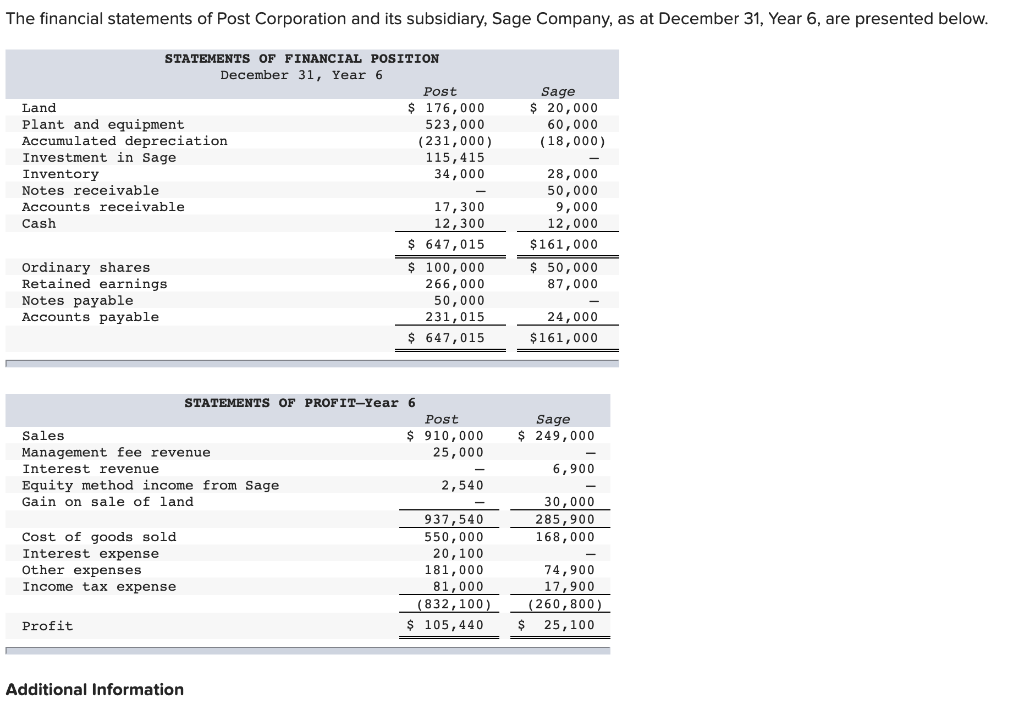
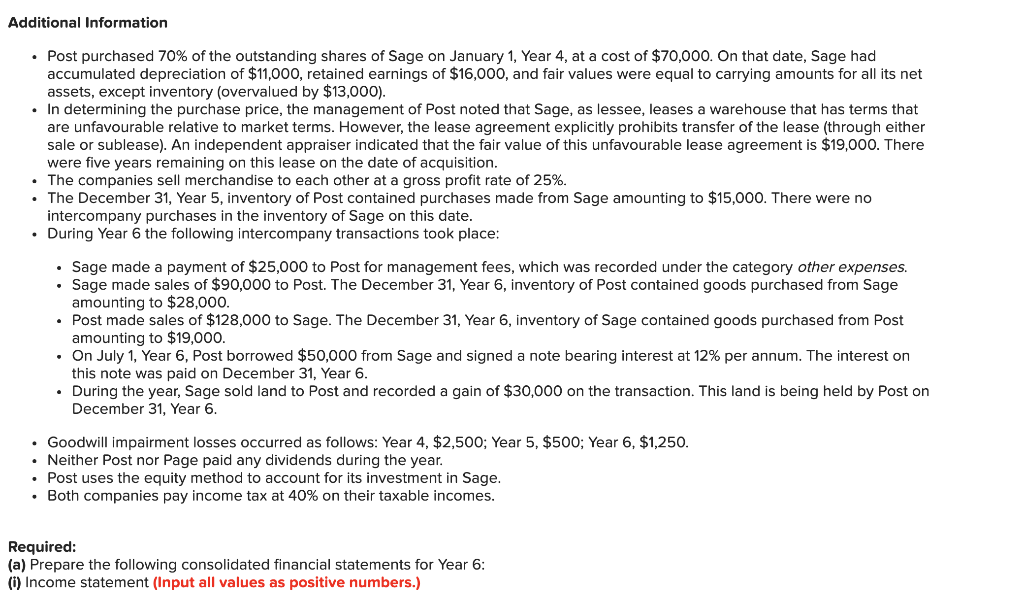
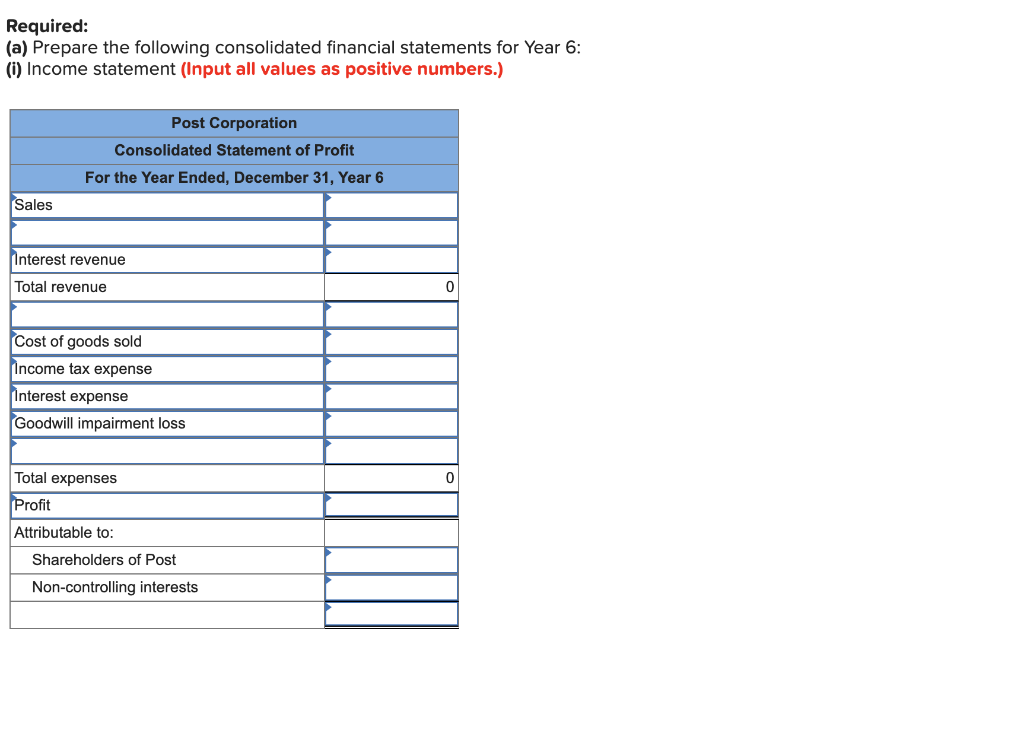
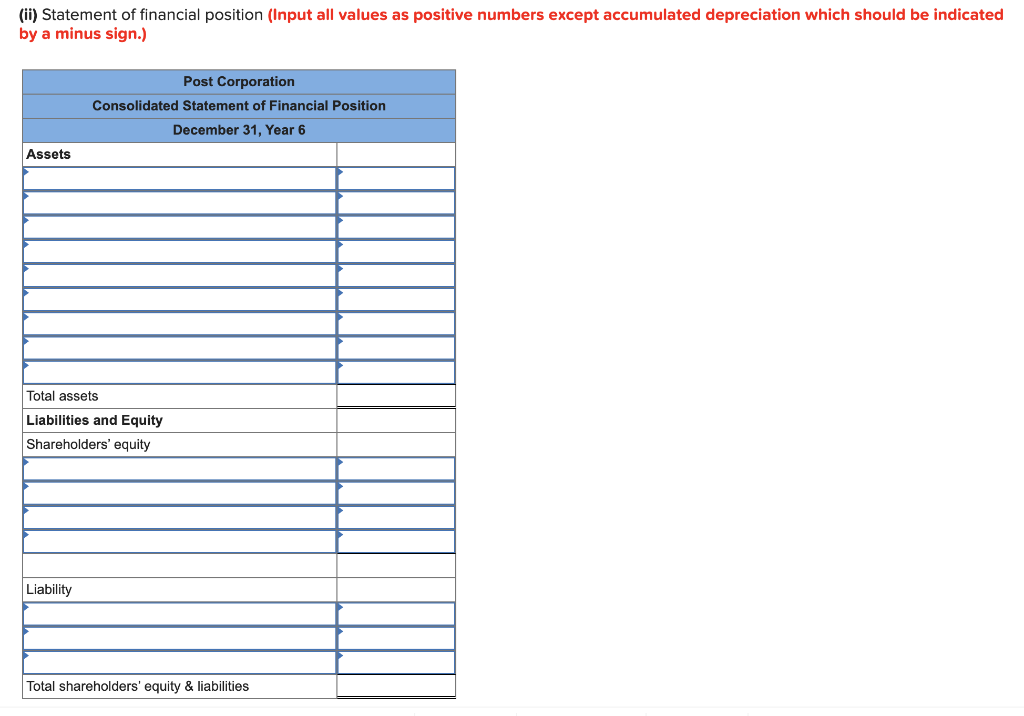

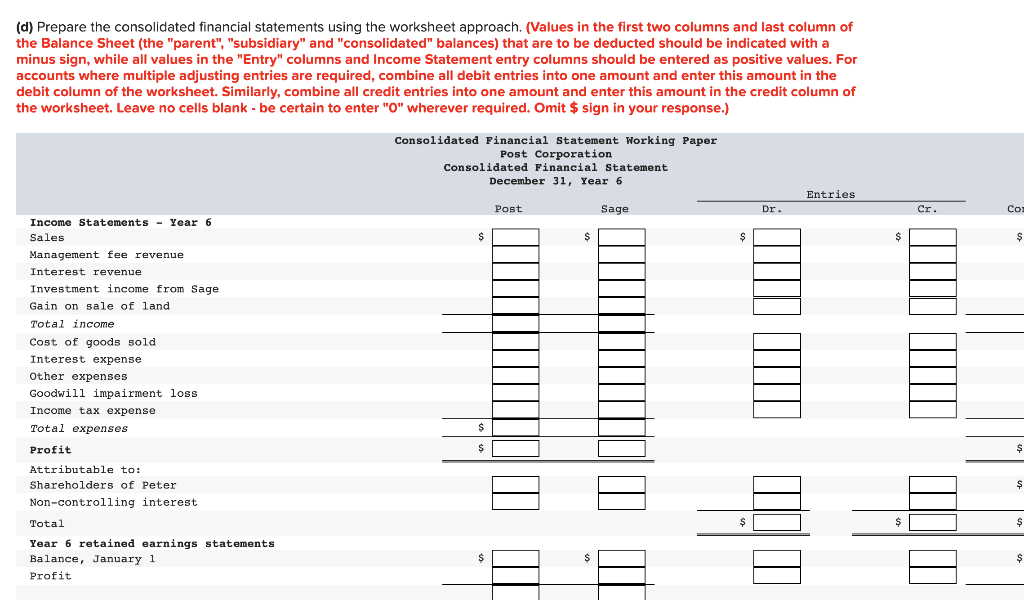
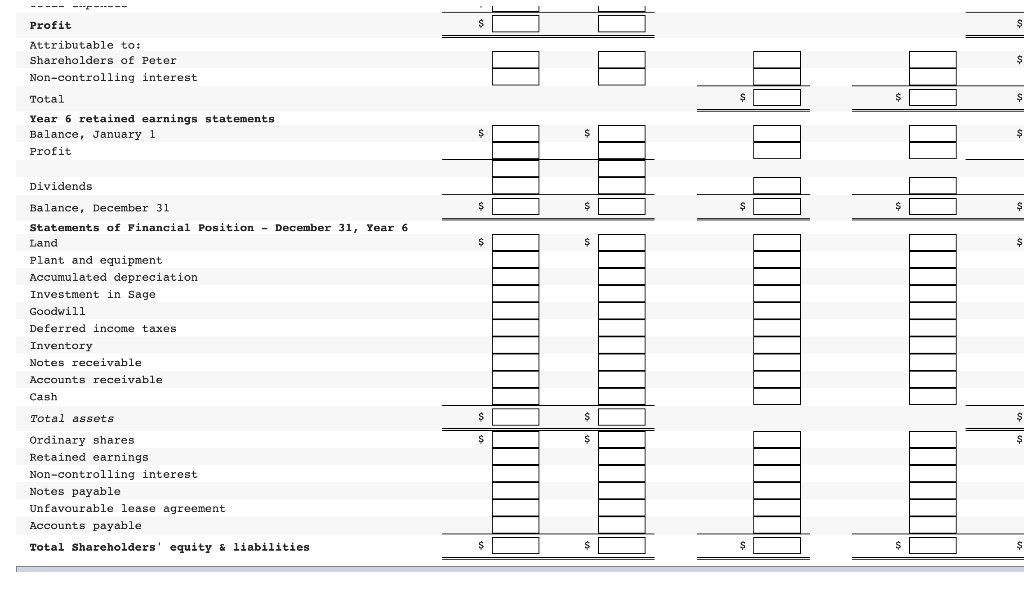
The financial statements of Post Corporation and its subsidiary, Sage Company, as at December 31, Year 6, are presented below. Sage $ 20,000 60,000 (18,000) STATEMENTS OF FINANCIAL POSITION December 31, Year 6 Post Land $ 176,000 Plant and equipment 523,000 Accumulated depreciation (231,000) Investment in Sage 115,415 Inventory 34,000 Notes receivable Accounts receivable 17,300 Cash 12,300 $ 647,015 Ordinary shares $ 100,000 Retained earnings 266,000 Notes payable 50,000 Accounts payable 231,015 $ 647,015 28,000 50,000 9,000 12,000 $ 161,000 $ 50,000 87,000 24,000 $ 161,000 Sage $ 249,000 6,900 STATEMENTS OF PROFIT-Year 6 Post Sales $ 910,000 Management fee revenue 25,000 Interest revenue Equity method income from Sage 2,540 Gain on sale of land 937,540 Cost of goods sold 550,000 Interest expense 20,100 Other expenses 181,000 Income tax expense 81,000 (832,100) Profit $ 105,440 30,000 285, 900 168,000 74,900 17,900 (260,800) $ 25,100 Additional Information Additional Information Post purchased 70% of the outstanding shares of Sage on January 1, Year 4, at a cost of $70,000. On that date, Sage had accumulated depreciation of $11,000, retained earnings of $16,000, and fair values were equal to carrying amounts for all its net assets, except inventory (overvalued by $13,000). In determining the purchase price, the management of Post noted that Sage, as lessee, leases a warehouse that has terms that are unfavourable relative to market terms. However, the lease agreement explicitly prohibits transfer of the lease (through either sale or sublease). An independent appraiser indicated that the fair value of this unfavourable lease agreement is $19,000. There were five years remaining on this lease on the date of acquisition. The companies sell merchandise to each other at a gross profit rate of 25%. The December 31, Year 5, inventory of Post contained purchases made from Sage amounting to $15,000. There were no intercompany purchases in the inventory of Sage on this date. . During Year 6 the following intercompany transactions took place: Sage made a payment of $25,000 to Post for management fees, which was recorded under the category other expenses. Sage made sales of $90,000 to Post. The December 31, Year 6, inventory of Post contained goods purchased from Sage amounting to $28,000. Post made sales of $128,000 to Sage. The December 31, Year 6, inventory of Sage contained goods purchased from Post amounting to $19,000. . On July 1, Year 6, Post borrowed $50,000 from Sage and signed a note bearing interest at 12% per annum. The interest on this note was paid on December 31, Year 6. During the year, Sage sold land to Post and recorded a gain of $30,000 on the transaction. This land is being held by Post on December 31, Year 6. Goodwill impairment losses occurred as follows: Year 4, $2,500; Year 5, $500; Year 6, $1,250. Neither Post nor Page paid any dividends during the year. Post uses the equity method to account for its investment in Sage. . Both companies pay income tax at 40% on their taxable incomes. Required: (a) Prepare the following consolidated financial statements for Year 6: (1) Income statement (Input all values as positive numbers.) Required: (a) Prepare the following consolidated financial statements for Year 6: (i) Income statement (Input all values as positive numbers.) Post Corporation Consolidated Statement of Profit For the Year Ended, December 31, Year 6 Sales Interest revenue Total revenue 0 Cost of goods sold Income tax expense Interest expense Goodwill impairment loss 0 Total expenses Profit Attributable to: Shareholders of Post Non-controlling interests (ii) Statement of financial position (Input all values as positive numbers except accumulated depreciation which should be indicated by a minus sign.) Post Corporation Consolidated Statement of Financial Position December 31, Year 6 Assets Total assets Liabilities and Equity Shareholders' equity Liability Total shareholders' equity & liabilities (b) Calculate goodwill impairment loss and profit attributable to non-controlling interest for the year ended December 31, Year 6, under the identifiable net assets method. (Omit $ sign in your response.) $ Goodwill impairment loss identifiable net assets method NCI identifiable net assets method $ (c) Calculate goodwill and non-controlling interest on the consolidated statement of financial position at December 31, Year 6, under the identifiable net assets method. (Omit $ sign in your response.) $ Goodwill identifiable net assets method NCI identifiable net assets method $ (d) Prepare the consolidated financial statements using the worksheet approach. (Values in the first two columns and last column of the Balance Sheet (the "parent", "subsidiary" and "consolidated" balances) that are to be deducted should be indicated with a minus sign, while all values in the "Entry" columns and Income Statement entry columns should be entered as positive values. For accounts where multiple adjusting entries are required, combine all debit entries into one amount and enter this amount in the debit column of the worksheet. Similarly, combine all credit entries into one amount and enter this amount in the credit column of the worksheet. Leave no cells blank - be certain to enter "O" wherever required. Omit $ sign in your response.) Consolidated Financial Statement Working Paper Post Corporation Consolidated Financial Statement December 31, Year 6 Entries Post Sage Dr. Cr. Coi S S s $ $ Income Statements - Year 6 Sales Management fee revenue Interest revenue Investment income from Sage Gain on sale of land Total income Cost of goods sold Interest expense Other expenses Goodwill impairment loss Income tax expense Total expenses Profit Attributable to: Shareholders of Peter Non-controlling interest Total Year 6 retained earnings statements Balance, January 1 Profit $ $ $ $ $ $ $ $ ------------- Profit Attributable to: Shareholders of Peter Non-controlling interest Total Year 6 retained earnings statements Balance, January 1 Profit $ $ $ Dividends $ $ s $ $ $ $ Balance, December 31 Statements of Financial Position - December 31, Year 6 Land Plant and equipment Accumulated depreciation Investment in Sage Goodwill Deferred income taxes Inventory Notes receivable Accounts receivable Cash $ $ $ $ $ Total assets Ordinary shares Retained earnings Non-controlling interest Notes payable Unfavourable lease agreement Accounts payable Total Shareholders' equity & liabilities $ $ $ $ The financial statements of Post Corporation and its subsidiary, Sage Company, as at December 31, Year 6, are presented below. Sage $ 20,000 60,000 (18,000) STATEMENTS OF FINANCIAL POSITION December 31, Year 6 Post Land $ 176,000 Plant and equipment 523,000 Accumulated depreciation (231,000) Investment in Sage 115,415 Inventory 34,000 Notes receivable Accounts receivable 17,300 Cash 12,300 $ 647,015 Ordinary shares $ 100,000 Retained earnings 266,000 Notes payable 50,000 Accounts payable 231,015 $ 647,015 28,000 50,000 9,000 12,000 $ 161,000 $ 50,000 87,000 24,000 $ 161,000 Sage $ 249,000 6,900 STATEMENTS OF PROFIT-Year 6 Post Sales $ 910,000 Management fee revenue 25,000 Interest revenue Equity method income from Sage 2,540 Gain on sale of land 937,540 Cost of goods sold 550,000 Interest expense 20,100 Other expenses 181,000 Income tax expense 81,000 (832,100) Profit $ 105,440 30,000 285, 900 168,000 74,900 17,900 (260,800) $ 25,100 Additional Information Additional Information Post purchased 70% of the outstanding shares of Sage on January 1, Year 4, at a cost of $70,000. On that date, Sage had accumulated depreciation of $11,000, retained earnings of $16,000, and fair values were equal to carrying amounts for all its net assets, except inventory (overvalued by $13,000). In determining the purchase price, the management of Post noted that Sage, as lessee, leases a warehouse that has terms that are unfavourable relative to market terms. However, the lease agreement explicitly prohibits transfer of the lease (through either sale or sublease). An independent appraiser indicated that the fair value of this unfavourable lease agreement is $19,000. There were five years remaining on this lease on the date of acquisition. The companies sell merchandise to each other at a gross profit rate of 25%. The December 31, Year 5, inventory of Post contained purchases made from Sage amounting to $15,000. There were no intercompany purchases in the inventory of Sage on this date. . During Year 6 the following intercompany transactions took place: Sage made a payment of $25,000 to Post for management fees, which was recorded under the category other expenses. Sage made sales of $90,000 to Post. The December 31, Year 6, inventory of Post contained goods purchased from Sage amounting to $28,000. Post made sales of $128,000 to Sage. The December 31, Year 6, inventory of Sage contained goods purchased from Post amounting to $19,000. . On July 1, Year 6, Post borrowed $50,000 from Sage and signed a note bearing interest at 12% per annum. The interest on this note was paid on December 31, Year 6. During the year, Sage sold land to Post and recorded a gain of $30,000 on the transaction. This land is being held by Post on December 31, Year 6. Goodwill impairment losses occurred as follows: Year 4, $2,500; Year 5, $500; Year 6, $1,250. Neither Post nor Page paid any dividends during the year. Post uses the equity method to account for its investment in Sage. . Both companies pay income tax at 40% on their taxable incomes. Required: (a) Prepare the following consolidated financial statements for Year 6: (1) Income statement (Input all values as positive numbers.) Required: (a) Prepare the following consolidated financial statements for Year 6: (i) Income statement (Input all values as positive numbers.) Post Corporation Consolidated Statement of Profit For the Year Ended, December 31, Year 6 Sales Interest revenue Total revenue 0 Cost of goods sold Income tax expense Interest expense Goodwill impairment loss 0 Total expenses Profit Attributable to: Shareholders of Post Non-controlling interests (ii) Statement of financial position (Input all values as positive numbers except accumulated depreciation which should be indicated by a minus sign.) Post Corporation Consolidated Statement of Financial Position December 31, Year 6 Assets Total assets Liabilities and Equity Shareholders' equity Liability Total shareholders' equity & liabilities (b) Calculate goodwill impairment loss and profit attributable to non-controlling interest for the year ended December 31, Year 6, under the identifiable net assets method. (Omit $ sign in your response.) $ Goodwill impairment loss identifiable net assets method NCI identifiable net assets method $ (c) Calculate goodwill and non-controlling interest on the consolidated statement of financial position at December 31, Year 6, under the identifiable net assets method. (Omit $ sign in your response.) $ Goodwill identifiable net assets method NCI identifiable net assets method $ (d) Prepare the consolidated financial statements using the worksheet approach. (Values in the first two columns and last column of the Balance Sheet (the "parent", "subsidiary" and "consolidated" balances) that are to be deducted should be indicated with a minus sign, while all values in the "Entry" columns and Income Statement entry columns should be entered as positive values. For accounts where multiple adjusting entries are required, combine all debit entries into one amount and enter this amount in the debit column of the worksheet. Similarly, combine all credit entries into one amount and enter this amount in the credit column of the worksheet. Leave no cells blank - be certain to enter "O" wherever required. Omit $ sign in your response.) Consolidated Financial Statement Working Paper Post Corporation Consolidated Financial Statement December 31, Year 6 Entries Post Sage Dr. Cr. Coi S S s $ $ Income Statements - Year 6 Sales Management fee revenue Interest revenue Investment income from Sage Gain on sale of land Total income Cost of goods sold Interest expense Other expenses Goodwill impairment loss Income tax expense Total expenses Profit Attributable to: Shareholders of Peter Non-controlling interest Total Year 6 retained earnings statements Balance, January 1 Profit $ $ $ $ $ $ $ $ ------------- Profit Attributable to: Shareholders of Peter Non-controlling interest Total Year 6 retained earnings statements Balance, January 1 Profit $ $ $ Dividends $ $ s $ $ $ $ Balance, December 31 Statements of Financial Position - December 31, Year 6 Land Plant and equipment Accumulated depreciation Investment in Sage Goodwill Deferred income taxes Inventory Notes receivable Accounts receivable Cash $ $ $ $ $ Total assets Ordinary shares Retained earnings Non-controlling interest Notes payable Unfavourable lease agreement Accounts payable Total Shareholders' equity & liabilities $ $ $ $













